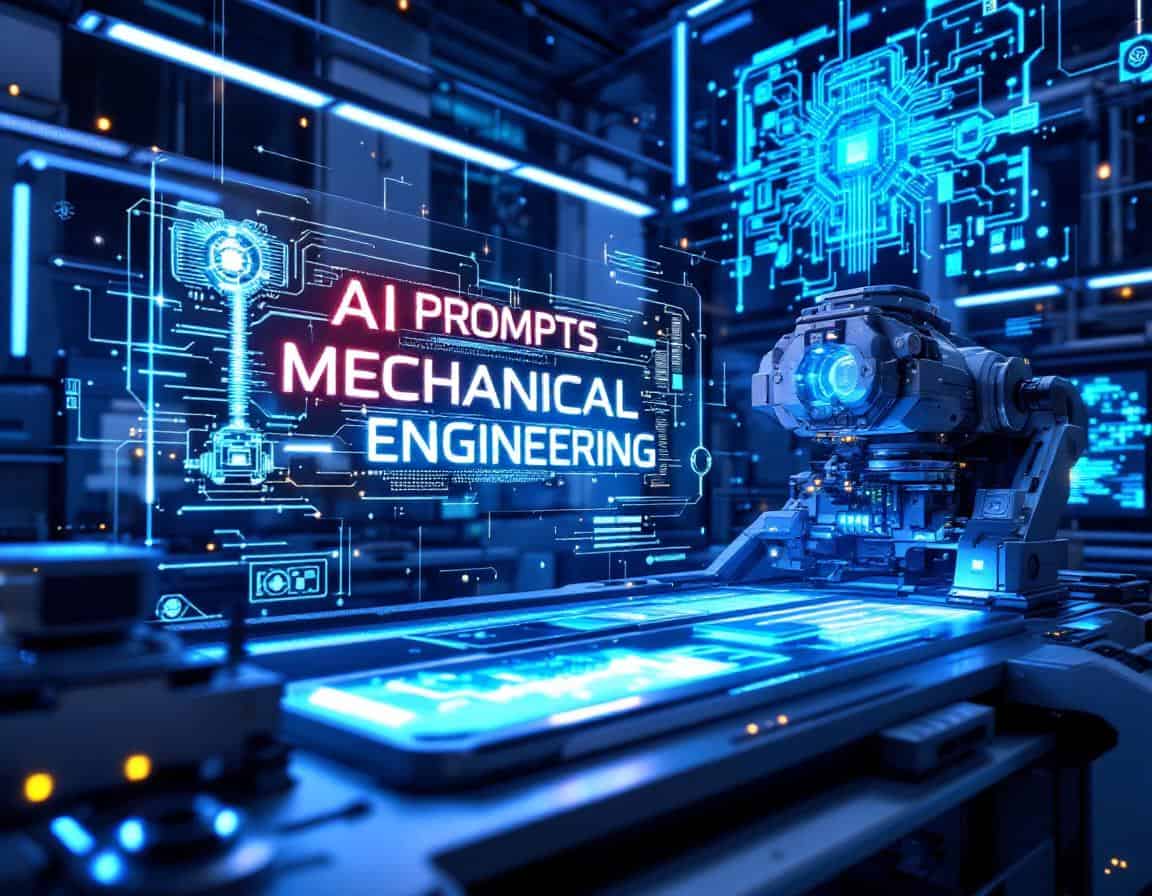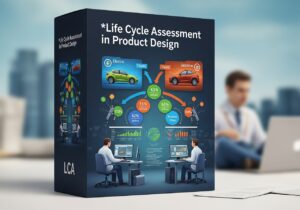
Gli strumenti di intelligenza artificiale online stanno rapidamente trasformando l'ingegneria meccanica aumentando le capacità umane di progettazione e analisi, produzionee manutenzione. Questi sistemi di intelligenza artificiale sono in grado di elaborare grandi quantità di dati, identificare modelli complessi e generare soluzioni innovative molto più rapidamente dei metodi tradizionali. Ad esempio, l'IA può aiutarvi a ottimizzare i progetti per le prestazioni e la producibilità, accelerare simulazioni complesse, prevedere le proprietà dei materiali e automatizzare un'ampia gamma di attività analitiche.
I suggerimenti forniti qui di seguito aiuteranno, ad esempio, a progettare in modo generativo, ad accelerare le simulazioni (FEA/CFD), ad aiutare nella manutenzione predittiva, dove l'intelligenza artificiale analizza i dati dei sensori dei macchinari per prevedere potenziali guasti, consentendo un'assistenza proattiva e riducendo al minimo i tempi di inattività, ad aiutare nella selezione dei materiali e molto altro ancora.
- Questa pagina è specifica per un dominio. Se necessario, è possibile disporre di funzionalità di ricerca complete per tutti i domini e tutti i criteri nel nostro > Elenco dei suggerimenti AI <, dedicato a progettazione del prodotto E innovazione.
- Per motivi di tempo e di risorse del server, le richieste sono riservate ai soli membri registrati e non sono visibili in basso se non si è registrati. È possibile registrarsi, 100% gratuitamente:
È necessaria l'iscrizione
Per accedere a questo contenuto è necessario essere membri.
- Analisi della causa principale
- Ingegneria meccanica
Prompt AI per Comparative RCA for Repetitive Failures
- Miglioramento continuo, Azione correttiva, Progettazione per la produzione (DfM), Analisi dei guasti, Produzione snella, Industria meccanica, Miglioramento dei processi, Gestione della qualità, Analisi della causa principale
Analyzes textual descriptions from multiple incident reports of a repetitive failure in a mechanical system. This prompt aims to identify common patterns potential shared root causes and any differentiating factors across incidents helping to solve persistent issues. The output is a markdown formatted comparative analysis.
Uscita:
- Markdown
- non richiede Internet in diretta
- Fields: {system_or_component_name} {common_failure_description} {multiple_failure_incident_reports_text}
- Best for: Assisting mechanical engineers in diagnosing recurrent system failures by comparatively analyzing multiple incident reports to identify common patterns and potential shared root causes.
- Considerazioni etiche e analisi dell'impatto
- Ingegneria meccanica
Prompt AI per Dual-Use Technology Ethical Assessment
- Fabbricazione additiva, Progettazione per la produzione additiva (DfAM), Impatto ambientale, Industria meccanica, Gestione del rischio, Pratiche di sostenibilità
Conducts a preliminary ethical assessment for a mechanical engineering technology that may have dual-use applications highlighting potential risks ethical dilemmas and proposing safeguards. This prompt aims to foster responsible innovation by considering unintended consequences. The output is a structured markdown report.
Uscita:
- Markdown
- non richiede Internet in diretta
- Fields: {technology_description_and_capabilities} {intended_civilian_application} {potential_misuse_concerns_list_csv}
- Best for: Assessing dual-use mechanical technologies for ethical risks and misuse potential guiding engineers in responsible innovation and proposing safeguards.
- Ottimizzazione del disegno sperimentale
- Ingegneria meccanica
Prompt AI per Experimental Plan Critique and Improvement Suggestions
- Analisi del design, Valutazione del progetto, Ottimizzazione del design, Miglioramento dei processi, Garanzia di qualità, Controllo di qualità, Analisi statistica, Validazione
This prompt asks the AI to analyze a provided experimental design in mechanical engineering, identifying weaknesses and proposing detailed improvements to enhance validity, reliability, and efficiency. The user inputs the experimental plan description and key variables.
Uscita:
- Testo
- non richiede Internet in diretta
- Fields: {experimental_plan} {key_variables}
- Best for: Best for optimizing experimental setups to yield more reliable and valid results
- Assistenza per le proposte di sovvenzione e la scrittura scientifica
- Ingegneria meccanica
Prompt AI per Grant Proposal Significance Section Draft
- Fabbricazione additiva, Progettazione per la produzione additiva (DfAM), Innovazione, Industria meccanica, Sviluppo del prodotto, Prototipazione, Ricerca e sviluppo, Pratiche di sostenibilità, Proposta di valore
Drafts the Significance and Innovation sections for a mechanical engineering grant proposal highlighting the project’s novelty research gap addressed and potential impact. This prompt helps engineers articulate the core value of their proposed work. The output is a markdown formatted text.
Uscita:
- Markdown
- non richiede Internet in diretta
- Fields: {project_title} {research_problem_statement} {proposed_solution_summary} {key_innovative_aspects_list_csv}
- Best for: Assisting mechanical engineers in drafting compelling Significance and Innovation sections for grant proposals ensuring clear articulation of research value and novelty.
- Ottimizzazione del disegno sperimentale
- Ingegneria meccanica
Prompt AI per Optimal Experimental Design Generator
- Progettazione per la produzione additiva (DfAM), Progettazione per la produzione (DfM), Industria meccanica, Ottimizzazione del processo, Garanzia di qualità, Controllo di qualità, Ricerca e sviluppo, Analisi statistica
This prompt instructs the AI to design an optimal experiment to investigate specified mechanical engineering parameters. The user provides the research question, variables to test, and constraints. The AI returns a full experimental plan with control groups, sample sizes, and measurement strategies.
Uscita:
- Markdown
- non richiede Internet in diretta
- Fields: {research_question} {variables} {constraints}
- Best for: Best for generating comprehensive, statistically sound mechanical engineering experiments
- Assistenza per le proposte di sovvenzione e la scrittura scientifica
- Ingegneria meccanica
Prompt AI per Technical Report Abstract Generator
- Miglioramento continuo, Progettazione per la produzione additiva (DfAM), Industria meccanica, Metodologia, Miglioramento dei processi, Gestione del progetto, Gestione della qualità, Ricerca e sviluppo, Pratiche di sostenibilità
Generates a concise and informative abstract for a technical report based on key sections of the report. This prompt helps engineers quickly summarize their work for wider dissemination. The output is a plain text abstract.
Uscita:
- Testo
- non richiede Internet in diretta
- Fields: {report_title} {project_objectives_summary} {methodology_used_summary} {key_results_and_conclusions_summary}
- Best for: Generating concise and well-structured abstracts for technical reports helping mechanical engineers efficiently summarize project objectives methods results and conclusions.
- Ottimizzazione del disegno sperimentale
- Ingegneria meccanica
Prompt AI per Statistical Power Analysis for Experiments
- Progettazione per Sei Sigma (DfSS), Miglioramento dei processi, Ottimizzazione del processo, Garanzia di qualità, Controllo di qualità, Analisi statistica, Controllo statistico del processo (SPC), Test statistici, Validazione
This prompt requests the AI to perform a statistical power analysis for a mechanical engineering experiment based on input parameters such as effect size, sample size, and significance level. It helps determine if the experiment is sufficiently powered.
Uscita:
- Testo
- non richiede Internet in diretta
- Fields: {effect_size} {sample_size} {significance_level}
- Best for: Best for validating experimental designs through power calculations
- Assistenza per le proposte di sovvenzione e la scrittura scientifica
- Ingegneria meccanica
Prompt AI per Critica della metodologia del documento di ricerca
- Progettazione per la produzione additiva (DfAM), Industria meccanica, Metodologia, Miglioramento dei processi, Garanzia di qualità, Controllo di qualità, Ricerca e sviluppo, Analisi statistica, Validazione
Esamina e suggerisce miglioramenti per la sezione metodologica di un documento di ricerca di ingegneria meccanica, concentrandosi sulla chiarezza, la completezza, la giustificazione e l'adeguatezza dei metodi utilizzati. Questa richiesta contribuisce a migliorare il rigore e la riproducibilità della ricerca. Il risultato è una critica in formato markdown.
Uscita:
- Markdown
- non richiede Internet in diretta
- Campi: {testo della sezione_metodologia_attuale} {testo_obiettivi_di_ricerca} {elenco_chiave_attrezzature_o_software_utilizzati_csv}
- Ideale per: Fornisce critiche costruttive dettagliate sulle sezioni metodologiche dei documenti di ricerca, aiutando gli ingegneri meccanici a migliorare il rigore della chiarezza e la riproducibilità del loro lavoro.
- Ottimizzazione del disegno sperimentale
- Ingegneria meccanica
Prompt AI per Creatore della lista di controllo per la convalida dei dati sperimentali
- Industria meccanica, Garanzia di qualità, Controllo di qualità, Gestione della qualità, Analisi statistica, Metodi di prova, Validazione, Verifica
Questa richiesta chiede all'IA di generare una lista di controllo dettagliata per la convalida della qualità e dell'integrità dei dati sperimentali di ingegneria meccanica, in base alla descrizione dell'esperimento e al tipo di dati forniti dall'utente.
Uscita:
- Markdown
- non richiede Internet in diretta
- Campi: {descrizione_esperimento} {tipo_di_dati}
- Ideale per: Il migliore per garantire una raccolta e un'analisi dei dati sperimentali affidabile e di alta qualità.
- Assistenza per le proposte di sovvenzione e la scrittura scientifica
- Ingegneria meccanica
Prompt AI per Struttura della revisione della letteratura per l'introduzione
- Fabbricazione additiva, Miglioramento continuo, Progettazione per la produzione additiva (DfAM), Innovazione, Industria meccanica, Gestione della qualità, Pratiche di sostenibilità
Aiuta a strutturare la revisione della letteratura per la sezione introduttiva di un documento di ricerca, identificando i temi chiave dagli abstract forniti e suggerendo un flusso logico per stabilire le lacune della ricerca per un argomento di ingegneria meccanica. L'output è costituito da uno schema in markdown e da una guida narrativa.
Uscita:
- Markdown
- non richiede Internet in diretta
- Campi: {titolo_argomento_di_ricerca} {list_of_key_abstracts_or_papers_text} {capacità_di_ricerca_o_domanda_principale}
- Il migliore per: Aiutare gli ingegneri meccanici a strutturare la revisione della letteratura nell'introduzione di un documento di ricerca, organizzando tematicamente le informazioni provenienti dagli abstract esistenti e conducendo logicamente verso la lacuna della ricerca.



























Stiamo dando per scontato che l'IA possa sempre generare i migliori prompt in ingegneria meccanica? Come vengono generati?
L'intelligenza artificiale renderà superflui gli ingegneri umani?
Post correlati
Greenwashing: i 15 migliori consigli di un gentiluomo per un inganno squisito
Come combattere al meglio un brevetto in sospeso
Tutti gli stati dei brevetti: PCT vs Brevetto in attesa vs Brevetto pubblicato vs Brevetto concesso
Le 10 migliori strategie e strumenti per l'invalidazione dei brevetti
Valutazione del ciclo di vita (LCA) nella progettazione del prodotto in particolare
Panoramica dell'analisi del valore del prodotto